There are many effective ways to tone your leg without hitting the gym, and bodyweight exercises are one of them.
Bodyweight leg exercises are a great way to work out at home. You can build strength and muscle without using any equipment. They train multiple muscle groups, including the quadriceps, hamstrings, glutes, and calves.
I thought heavy lifting was the only way to build strong legs. But when I did bodyweight squats and lunges, I got stronger and toned legs.
So, if you want to build powerful legs without touching a barbell, these bodyweight exercises are for you.
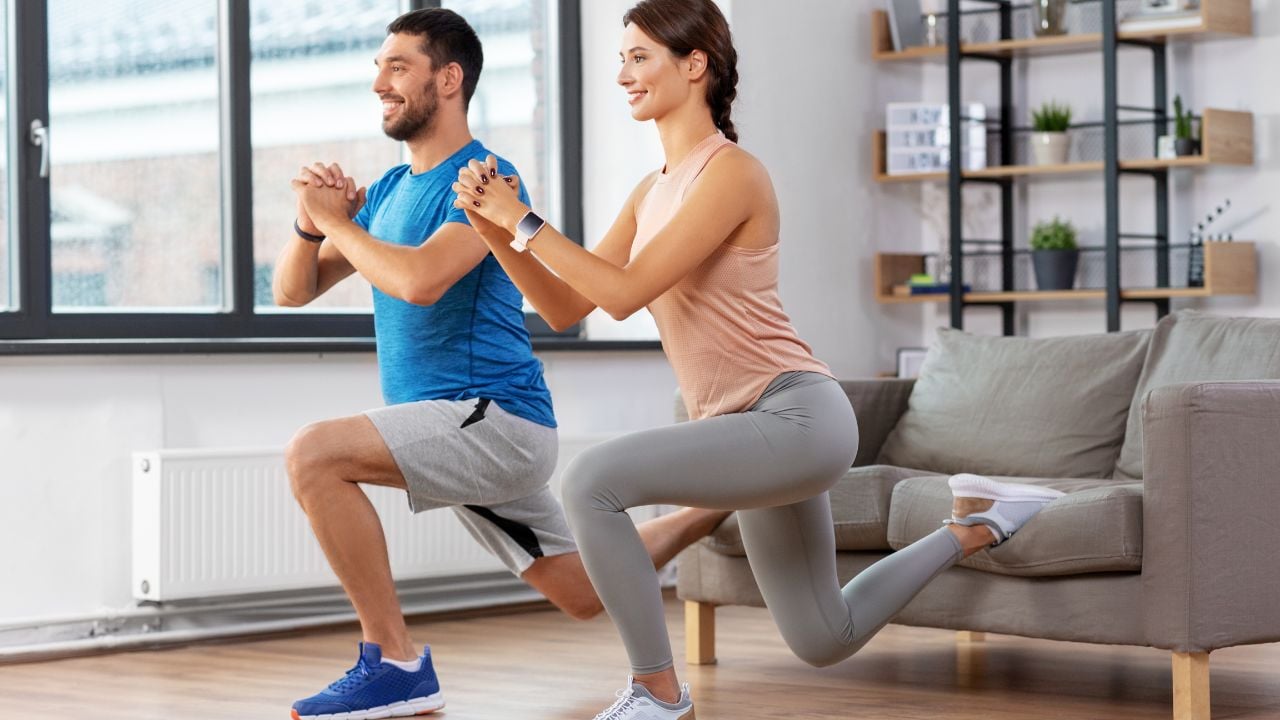
- 15 Best Legs Exercises for Beginners
- 1. Bodyweight Squat
- 2. Bodyweight Sumo Squat
- 3. Lunges
- 4. Inverse leg curl
- 5. Sissy Squat
- 6. Step Up
- 7. Hip Bridge
- 8. Good Morning Exercise
- 9. Jump Squat
- 10. Hip Thrust
- 11. Bulgarian Split Squat
- 12. One-Arm Bench Dip
- 13. Jumping Rope
- 14. Bodyweight Standing Calf Raise
- 15. Squat Hold Calf Raises
- Bonus: Curtsy Lunge
- How To Design A Bodyweight Leg Workout Routine
- 1. Set and Reps To Mass, Power, and Endurance
- 2. Select Weekly Workout Volume
- 3. Weekly Frequency
- 4. Progression
- 5. Add Warm-Up Exercises Before Leg Workout
- 6. Add Cool-Down and Stretching After Workout
- Bodyweight Leg Routines (Without Equipment)
- At Home Beginner Bodyweight Leg Workout
- Intermediate Workout Plan
- Weekly At-Home Bodyweight Leg Workout Plans
- 8-Week Bodyweight Leg Workout Plan
- 12-Week Bodyweight Leg Workout Plan
- FAQs
- Bodyweight leg exercises for explosiveness
- Bodyweight leg exercises for beginners
- Can I build leg muscle without weights?
- Can bodyweight leg exercises help with weight loss?
- Takeaways
15 Best Legs Exercises for Beginners
Here are our best bodyweight leg workouts to help you start off on the right foot and make your leg day much more interesting.
1. Bodyweight Squat
If you’re looking for straightforward bodyweight leg exercises to add to your routine, the bodyweight squat is a great staple exercise to start with.
This strengthening exercise can be performed virtually anywhere without equipment and limited space. It’s a highly functional movement that works all the major muscles of the legs. It improves the release of growth hormone and increases the metabolic rate.
Beginners need to learn the bodyweight squat before progressing to weighted squats.
Beginner Variation
- Wall Squat (using a wall for support)
- Chair Squat (squatting down to touch a chair before standing up)
- Bodyweight Box Squat (squatting down onto a box or bench)
Advanced Variation
- Pistol Squats (single-leg squats)
- Plyometric Squats (explosive jumps at the top of the squat)
- Prisoner Squats (hands behind your head)

How To Do
- Stand with your feet shoulder-width apart.
- Your knees and feet should be pointing in the same direction.
- Raise your arms out in front of you for balance (or you can leave them by your side)
- Inhale as you squat, simultaneously flexing your hips and knees.
- Lower down at least until your thighs are parallel to the floor.
- Exhale as you return to the starting position.
Tips
- Keep your back straight, head up, and torso upright.
- Don’t allow your knees to push too far forward.
- Make the bodyweight squat more difficult by pulsing at the bottom of the squat.
2. Bodyweight Sumo Squat
The Sumo Squat is a variation of a standard squat. The key difference in this squat is that you take a wider stance and position your feet turned out.
While all squats work the glutes, hip flexors, quads, hamstrings, and calves, the sumo squat’s leg positioning also works the inner thighs.
When performed in high volume, it is a great movement option for a high-intensity interval training (HIIT) workout.
- Beginner variations: Sumo Squat Pulse
- Advance variations: Jump Sumo Squats, Sumo Squat with Calf Raise

How To Do
- Stand with your feet slightly wider than hip-width apart and turn your feet out, externally rotating your hips.
- You can keep your hands clasped together at your chest or open your hands in front of your chest.
- Take a deep breath in, then push your hips backward, lowering into a squat.
- Keep your core tight, back straight, and knees forward.
- Pause, then exhale. As you return to your starting position.
Tips
- The lower back should have a natural arch with a chest out.
- Keep your abs tight throughout the exercise.
3. Lunges
Bodyweight Lunges are an excellent leg exercise to build thigh muscles and glutes. Along with squats, lunges are highly recommended to build mass in your butt and quad muscles.
Beginner Variation
- Walking Lunges (moving forward with each lunge)
- Static Lunges (holding the lunge position without moving)
Advance Variation
- Jumping Lunges (switching legs mid-air)
- Lateral Lunges (stepping to the side instead of forward)
- Clock Lunges (stepping in different directions, like 12, 3, 6, and 9 o’clock)
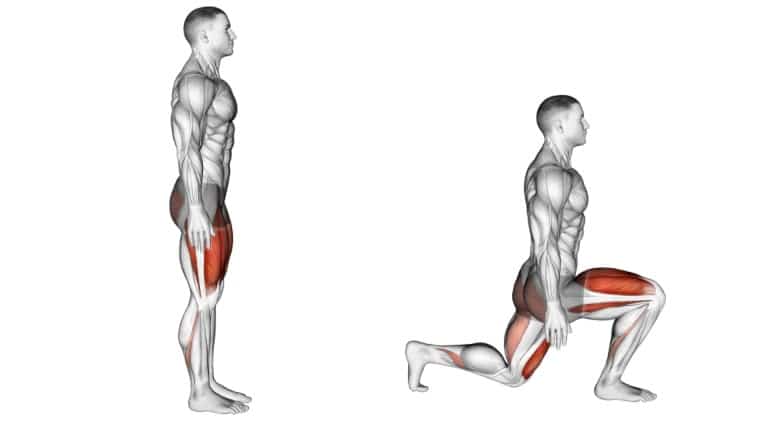
How To Do
- Keep your arms by your sides and stand upright.
- Keep your back straight, take a step forward, bend your knees, and get them as close to the floor as possible.
- Push yourself back to the starting position and repeat with the other foot.
- Keep alternating the leg with which you lunge.
Tips
- Bend as far and low as possible without losing form.
- Keep your torso upright and your head facing forward.
4. Inverse leg curl
If you’re looking for a way to get more creative with bodyweight exercises for the leg, try an inverted leg curl.
It is an unconventional hamstring exercise that isn’t common, but that doesn’t make it any less effective.
The inverse leg curl (bench support) uses your body weight to work the hamstrings and is just as challenging, if not more so.
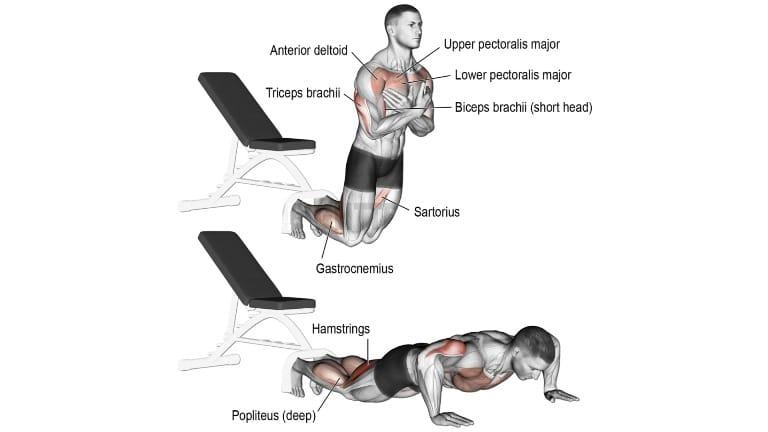
How To Do
- Get on your knees and anchor the back of your heels under a bench or a barbell.
- Cross your arms over your chest, or you can keep them by your sides.
- Inhale as you allow your body to slowly fall forward, controlling the descent as much as possible with your hamstrings.
- At the bottom of the movement, catch your body with your arms and lower your torso to the floor like a knee push-up.
- Exhale as you push your torso back up and off the floor just enough until your hamstrings can take over and pull your body back up to a vertical position.
Tips
- Use your arms as minimally as possible.
- To protect your knees, use a mat.
5. Sissy Squat
The sissy squat is a bodyweight quad exercise that also works on your hip flexors and strengthens your core simultaneously.
While doing that exercise, act as if you were kneeling on the ground without moving your upper body. The only moving part of your body is the lower portion of the leg.
To add resistance, hold a weight plate on your chest with the arm that is not stabilizing your body.

How To Do
- Stand with your feet hip-width to shoulder-width apart, and hold on to something sturdy that can support you.
- The best way to ensure that this exercise is executed correctly is to keep your hips and back straight.
- Bend at the knees and lean backward so that the tension is in the front of your thighs.
- Lower back as far as you can.
- Reverse the motion and return to the starting position.
Tips
- Keep your feet and knees pointing in the same direction.
- Keep your back and hips straight.
6. Step Up
The step-up is a great exercise for building leg strength and power. It targets quads and also involves calves, glutes, and hip flexors.
It can be modified to create a challenging workout for anyone, whether they have just started exercising or have been training for years.
You could also try the following variation to make it more challenging.
- Weighted Step-Up
- Single-Leg Step-Up

How To Do
- Place a knee-high box or bench in front of you.
- Stand with your feet in a comfortable hip-width stance.
- Step forward with one leg onto the step and drive through that thigh to bring your body upward.
- Bring the trailing leg to the top of the step and stand on the box.
- Then, step back with the opposite leg to the floor and lower yourself.
- Alternate legs with each rep.
Tips
- Control the movement, using your muscles to lift and lower yourself slowly.
- Be sure to keep your lower back in its natural arch and your upper body upright throughout the whole movement.
7. Hip Bridge
Strong glutes and hip muscles are essential for various athletic activities, including running, jumping, and change-of-direction movements.
A hip bridge, also known as a glute bridge, is a good starter move for the glutes, hips, hamstrings, and lower back muscles.
Research shows high gluteal muscle activity during a single-leg bridge compared to other gluteal strengthening exercises.
To make it more interesting and challenging, try experimenting with:
- Stability Ball Hip Bridge
- Weighted Hip Bridge
- Marching Hip Bridge
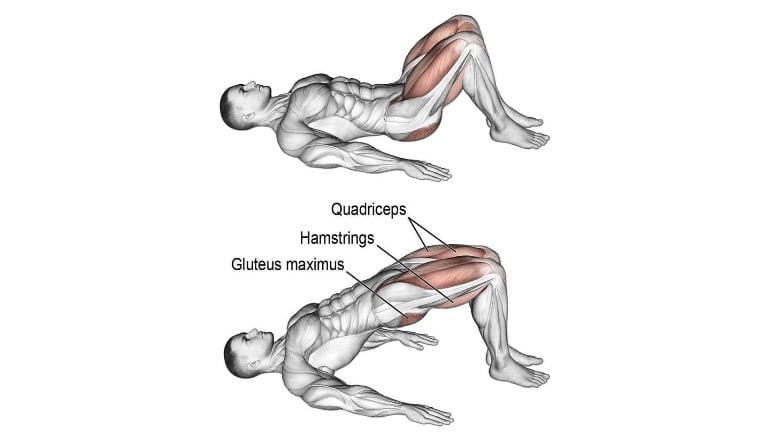
How To Do
- Lie face up on the floor, with your knees bent and feet flat on the ground.
- Keep your arms at your side with your palms down.
- Lift your hips off the ground until your knees and shoulders form a straight line.
- Squeeze those glutes hard and keep your abs drawn in.
- Hold your bridged position for a couple of seconds before easing back down.
Tips
- Don’t overextend your back during the exercises, and this may cause lower back pain.
- Hold a weight plate on your lap to make the Hip bridge exercise more difficult.
8. Good Morning Exercise
The good-morning is one of the best bodyweight leg exercises for mass and strength. It primarily targets the muscles of the lower back, hamstrings, and glutes.
- The erector spinae muscles of the lower back work isometrically to keep the spine in an extended position,
- While the hamstrings and gluteus maximus work isotonically to perform hip extension.
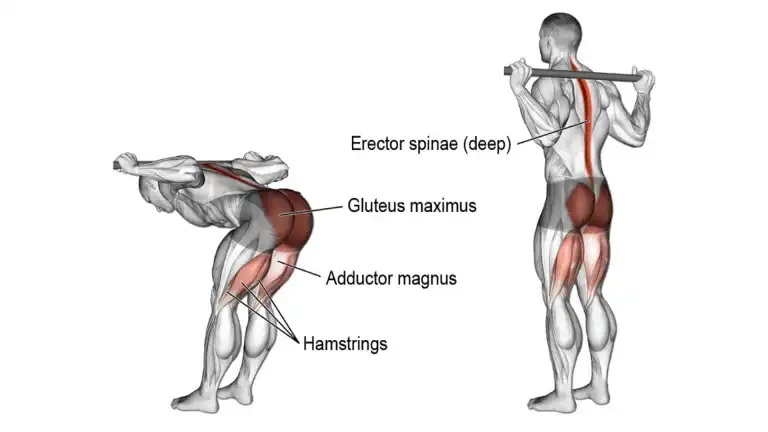
How To Do
- Stand holding a stick (or Weight) on the back of your shoulders, grasping the stick at each side.
- It can also perform the exercise as in the bodyweight version.
- Keep your knees slightly flexed and your back and neck neutral.
- Inhale as you flex your hips to lower your torso until it is close to or fully horizontal.
- Exhale as you raise your torso back up to the starting position by extending your hips.
Tips
- Keep your back and neck neutral throughout the exercise.
- It is recommended that the lifter avoid rounding (flexing) or rotation (twisting) at any point during the movement.
- Keep the movement slow, the form strict, and the weight light.
Read More: 15 Best Hamstring Exercises For Mass And Strength
9. Jump Squat
Jump squats, also known as squat jumps, are the power—packed HIIT version of squats.
And their variations help shed fat from the body, tone your butt and legs, and improve strength and balance. You must include it in your home workouts.
For a more advanced version, try:
- Tuck Jump Squat: Perform a jump squat, and at the peak of your jump, bring your knees up towards your chest, tucking them in before landing.
- Broad Jump Squat: Begin with a squat, then explode forward into a long jump. Upon landing, immediately return to a squat.

How To Do
- Stand with your feet about shoulder-width apart and your knees slightly bent.
- Quickly drop by bending at the knees and hips, letting your glutes track backward, and lowering yourself into a squat.
- When your thighs are parallel to the floor, quickly reverse direction and drive up through your heels and the balls of your feet to lift your body off the floor as high as possible.
- Land with soft knees and immediately lower into the next rep.
Tips
- Keep your head up and your torso upright.
- Don’t perform this exercise with cold muscles.
Know Your Fat Loss Calories Requirement: Weight Loss Calculator
10. Hip Thrust
The hip thrust is a popular exercise that targets the glutes and hamstrings for muscle and strength-building purposes.
Now, many people are afraid to perform this movement or are just not interested because it requires a little setup and may even look a little funny.
More challenging variations:
- Single-Leg Hip Thrust
- Band-Resisted Hip Thrust
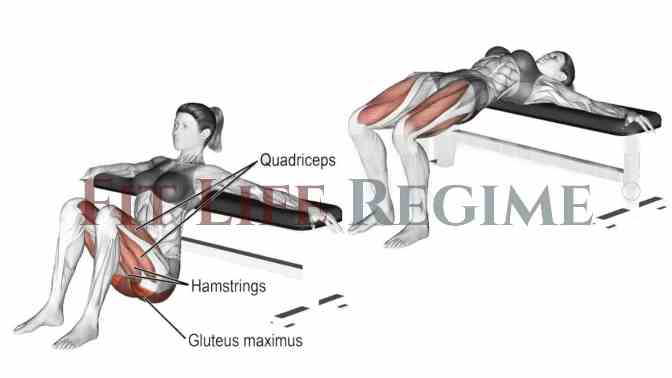
How To Do
- Lie down on a bench with your shoulder blades against the bench and your bottom on the floor.
- Spread your arms out on either side of you to rest on the bench.
- Bend your knees and, place your feet flat on the floor, approximately shoulder-width apart.
- Keep your torso rigid and core tight, and then lift your hips off the ground.
- Hold for a count of two and squeeze your glutes.
- Inhale as you lower the thigh by flexing your hips.
Tips
- Ensure that your neck stays neutral throughout the exercise.
- Make sure your bench is secure and won’t move before trying hip thrusts.
- Keep your torso rigid. Your back shouldn’t arch, and your pelvis shouldn’t tilt.
- All the movement should occur in your hips.
11. Bulgarian Split Squat
The Bulgarian split squat also known as the single-leg split squat is one of the best bodyweight leg exercises.
It is an effective auxiliary exercise for improving squats and lunges. It is also great for enhancing balance and developing unilateral functional strength.
To promote equal contralateral strength (equal strength on both sides), start with your weak leg and do not do more repetitions with your strong leg.
- Beginner variation: Supported Bulgarian Split Squat.
- Advanced variation: Bulgarian Split Squat on Bosu Ball

How To Do
- Keep your arms by your sides, and stand with your back facing the side of a bench.
- There should be three or four feet of space between you and the bench.
- Extend one leg backward and place the top of your foot on the bench so that only one leg supports your body.
- Inhale as you squat down with your supporting leg until your back leg’s knee nearly touches the floor.
- Exhale as you push yourself back up to the starting position.
Tips
- When you squat, your front knee should not pass your toes.
- Keep your torso upright and your head facing forward.
12. One-Arm Bench Dip
The one-arm bench dip is a challenging and very effective movement that primarily targets your triceps, but your glutes and quads also get worked secondarily.
Now, this is not a beginner’s exercise or for someone who lacks adequate upper body strength.

How To Do
- Place your hands (palms) on the side of a flat bench with your back straight, knees bent, and feet flat on the floor.
- Slide your buttocks off the bench. Raise your left arm and right leg straight out in front of you.
- Your body weight should be supported by your right arm and left leg.
- Inhale as you flex your elbow to lower your body until you feel a mild stretch in your shoulder.
- Exhale as you extend your elbow to push your body back up to the starting position.
Tips
- Keep your elbow close to your body, and do not flare out.
- Keep both feet on the floor to make the one-arm bench dip easier.
13. Jumping Rope
Jumping rope utilizes muscles that the seated calf raises miss. It builds endurance for the calf muscles, as well as strength and coordination.
Furthermore, jumping rope provides endless variations to keep the exercise challenging.
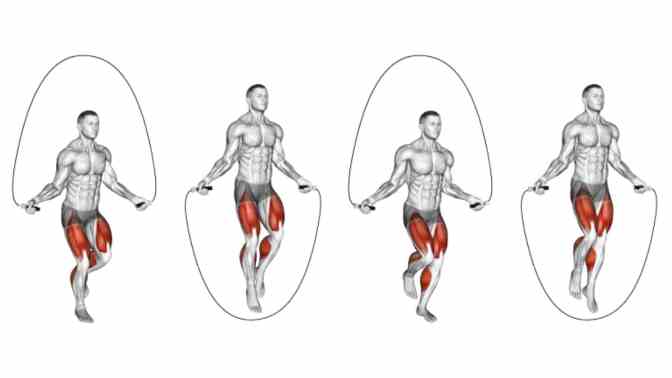
How To Do
- Hold the rope while keeping your hands at hip level.
- The knees must remain slightly bent to land softly and to keep it from locking.
- Rotate your wrists to swing the rope and jump.
- The rope is flicked over the head and passed under the feet by pushing the toes into a quick but gentle hop.
- Jump with both feet simultaneously, one foot at a time, alternating between feet, etc.
- Repeat until the set is complete.
Tips
- Keep the upper body straight, knees slightly bent, and jump on the balls of your feet.
- Engage your abs, loosen your shoulders, and turn the rope only with your wrists, not your entire arms.
- For a low-impact exercise, focus on doing faster and smaller jumps.
14. Bodyweight Standing Calf Raise
Bodyweight calf raise exercises effectively strengthen your calves because the calf muscles absorb so much of your body weight.
They only use body weight, so they’re a convenient calf exercise you can do at home or anywhere.

How To Do
- Stand up straight with your feet facing forward and placed hip-width apart.
- Keep a slight bend in your knee and hold your hands by your side
- Raise your heels by pressing the balls of your feet into the ground.
- You should move your body upwards until you’re standing on your toes.
- Hold this position, and then slowly lower your heels back to the ground.
Tips
- Pause and squeeze for a count of 1-2 at the movement’s top for added intensity.
- Keep the balls of your feet on the edge of the block/step. If you allow the balls of your feet to come in more, the exercise becomes easier.
Know More: Bodyweight Calf Raise To Build Mass And Strength Of Calves
15. Squat Hold Calf Raises
Squat-hold calf raises work the soleus muscles more than the gastrocnemius.
This exercise involves assuming a squat position, with feet shoulder-width apart and hands in front or placed on the hips.
While maintaining the squat position, the individual pushes up to stand on their tip toes and then back down to the ground.

How To Do
- Stand with your feet about three to four feet apart, toes turned out.
- Bring your hands together in front of your chest.
- Squat down by bending at the knees and hips, letting your glutes track backward to lower yourself into a squat.
- Raise your heel off the floor and squeeze your calves.
- Repeat until the set is complete.
Tips
- Keep your abs tight and your back straight, and maintain your knees aligned with your toes.
Bonus: Curtsy Lunge
The curtsy lunge targets the quadriceps and glutes, similar to the regular lunge.
This muscle plays a key role in stabilizing the hip. The hip adductors, which bring the thighs together, are also engaged during the curtsy lunge.
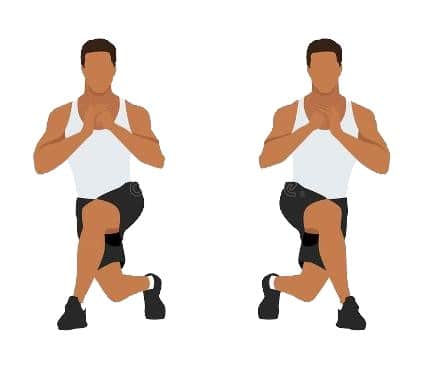
How To Do
- Stand up straight with your feet hip-width apart.
- Step your right foot diagonally behind your left leg, crossing it behind you as if you were doing a curtsy.
- Bend both knees and lower your body down towards the ground.
- Aim to bring your right knee close to the floor.
- Return to the starting position.
- Repeat the same movement with your left foot, stepping diagonally behind your right leg.
Tips
- Keep your knees tracking in line with your toes to prevent joint strain.
- Keep your upper body upright, with your chest lifted and core engaged.
How To Design A Bodyweight Leg Workout Routine
Structuring a leg workout program involves several key factors to consider, including exercise selection, volume, frequency, and progression.
However, the exercises you choose should match what you need to do to achieve your goals.
Instead of just picking random exercises to work on, we’ve included exercises that address one or more of the following key points, like improving muscle mass, strength, endurance, Power, and speed.
That way, you’re not wasting your efforts and building the specific attributes you need for your life. Win-win!
1. Set and Reps To Mass, Power, and Endurance
Do you care more about speed or endurance? Setting PRs in these particular exercises or building generally useable strength?
Once you’re clear, this table will help you work them into your routine:
| Goal | Recommended Sets/Reps |
|---|---|
| Mass | • 3-5 sets of 6-10 reps • Rest 60 seconds to 2 minutes between sets |
| Pure Strength | • 4-8 sets of 1-5 reps • Rest 2-3 minutes between sets |
| Endurance | • 2-5 sets of 12-25 reps • Rest 60-90 seconds between sets |
| Power and Speed | • 3-5 sets of 3-5 reps (but it will depend on when your explosiveness starts to fail) • Rest at least 2 minutes between sets |
2. Select Weekly Workout Volume
The volume of your workout program refers to the number of sets, reps, and exercises performed in each workout.
A good starting point is to perform 3–4 sets of each exercise for 8–12 reps.
- Beginners (with a year or less of training) should aim for about 12 weekly sets.
- An Intermediate trainee (with two to four years of training) can increase the volume to 16 sets per week.
- An advanced trainee (with four or more years of training) may be able to complete up to 20 weekly sets.
When a certain amount of volume stops working and your progress stalls, you can add sets to increase the volume and use that to make progress again.
3. Weekly Frequency
How often you perform leg workouts depends on your fitness level and goals.
- For beginners, 1-2 leg workouts per week are recommended
- While advanced lifters may benefit from 2-3 leg workouts per week.
4. Progression
Progression refers to gradually increasing the weight, reps, or sets over time to promote muscle growth and adaptation.
This can be achieved by increasing the weight lifted, increasing the number of reps performed, or decreasing rest time between sets.
5. Add Warm-Up Exercises Before Leg Workout
It’s important to do 5-10 minutes of warm-up exercises like jogging, High knees, jumping jacks, cycling, or dynamic stretching before working out your leg. This helps:
- Increases blood flow to the muscles.
- Raises the body temperature and improves muscle flexibility.
- Enhances mental focus and attention.
- Reduces the risk of injury by preparing the body for exercise.
6. Add Cool-Down and Stretching After Workout
People often overlook the importance of cooling down (decreasing in intensity at the end of a workout) and stretching (elongating muscles) after a workout. These activities help the body recover.
- Reducing muscle tension and increasing range of motion
- Improving flexibility and preventing muscle soreness.
- It helps remove metabolic waste products from the muscles, improving recovery.
Here is a list of exercises for cool-down and stretching:
- Standing quad stretch
- Hamstring stretch
- Butterfly stretch
- Seated forward bend
- Lizard pose
- Pigeon pose
- Frog pose
- Wall calf stretch
- Hip flexor stretch.
Bodyweight Leg Routines (Without Equipment)
Please note that these are just examples. A workout plan should be customized to fit your individual needs, abilities, and goals.
At Home Beginner Bodyweight Leg Workout
| Exercise | Sets x Reps | Rest |
| Bodyweight squats | 3 x 8 | 60-90 sec |
| Lunges | 3 x 10 | 60-90 sec |
| Glute bridge | 3 x 10 | 60-90 sec |
| Calf raises | 3 x 8 | 60-90 sec |
Intermediate Workout Plan
| Exercise | Sets x Reps | Rest |
| Squats | 3 x 8 | 45-60 sec |
| Jump Squat | 3 x 10 | 45-60 sec |
| Reverse Lunge | 3 x 10 | 45-60 sec |
| Standing calf raises | 3 x 8 | 45-60 sec |
| Bulgarian Split Squats | 3 x 8 | 45-60 sec |
Weekly At-Home Bodyweight Leg Workout Plans
The frequency of the bodyweight leg workout plan can vary depending on your goals, fitness level, and training schedule.
- If you are training your leg one day a week, then you should do all the exercises shown in the plan.
- If you are training your leg two times a week, then split the exercises shown into a weekly schedule.
I would recommend maintaining the same weekly leg workout volume.
8-Week Bodyweight Leg Workout Plan
Week 1-4:
- Bodyweight Squats – 4 sets of 12 reps
- Lunges – 3 sets of 10 reps (each leg)
- Calf Raises – 3 sets of 12 reps
- Standing Calf Raises – 3 sets of 12 reps
Week 5-8
- Single-Leg Squats – 4 sets of 8 reps (each leg)
- Glute Bridges – 4 sets of 8 reps
- Walking Lunges – 3 sets of 10 reps (each leg)
- Hip Thrust – 4 sets of 8 reps
- Calf Raises – 3 sets of 12 reps
12-Week Bodyweight Leg Workout Plan
Week 1-4
- Bodyweight Squats – 3 sets of 12 reps
- Reverse Lunges – 3 sets of 10 reps (each leg)
- Glute Bridges – 3 sets of 12 reps (each leg)
- Calf Raises – 3 sets of 15 reps
- Plyometric Squat Jumps – 3 sets of 10 reps
Week 5-8
- Bodyweight Squats – 3 sets of 12 reps
- Jumping Lunges – 3 sets of 10 reps (each leg)
- Calf Raises with a Pause – 3 sets of 15 reps
- Bulgarian Split Squats – 3 sets of 10 reps (each leg)
- Step up – 3 sets of 8 reps
Week 9-12
- Squat Jumps – 3 sets of 10 reps
- Walking Lunges – 3 sets of 12 reps (each leg)
- Glute Bridge Marches – 3 sets of 12 reps
- Calf Raises on a Step – 3 sets of 15 reps
- Box Jumps – 3 sets of 8 reps
These are sample exercise plans that you can modify to meet your needs and goals.
FAQs
Bodyweight leg exercises for explosiveness
- Jump Squats
- Split Jumps
- Tuck Jumps
- Broad Jumps
- Lateral Bounds
- Skater Jumps
- Single-Leg Box Jumps
- Plyometric Lunges
- Power Step-Ups
- High Knees
Bodyweight leg exercises for beginners
- Squats
- Lunges
- Step-ups
- Glute bridges
- Calf raises
- Wall sits
- Standing leg lifts
- Standing hip extensions
- Side lunges
- Seated knee extensions
Can I build leg muscle without weights?
Yes, you can build leg muscle without weights. Bodyweight leg exercises like squats, lunges, and glute bridges can help you build and strengthen your leg muscles.
Can bodyweight leg exercises help with weight loss?
Bodyweight leg exercises can help you lose weight when combined with a good fitness routine and a balanced diet. Weight loss is primarily achieved through a calorie deficit, which is created by burning more calories than you consume
Takeaways
Bodyweight leg exercises are a great way to build strength, improve flexibility, and sculpt your legs and glutes.
You can manipulate bodyweight exercise routines to focus on different fitness goals, such as muscle mass, strength, endurance, power and Speed.
Best of all, these exercises can be done anywhere, anytime. So next time you need to get your blood flowing after sitting for too long, try some of them.

Manish is a NASM-certified fitness and nutrition coach with over 10 years of experience in weight lifting and fat loss fitness coaching. He specializes in gym-based training and has a lot of knowledge about exercise, lifting technique, biomechanics, and more.
Through “Fit Life Regime,” he generously shares the insights he’s gained over a decade in the field. His goal is to equip others with the knowledge to start their own fitness journey.
